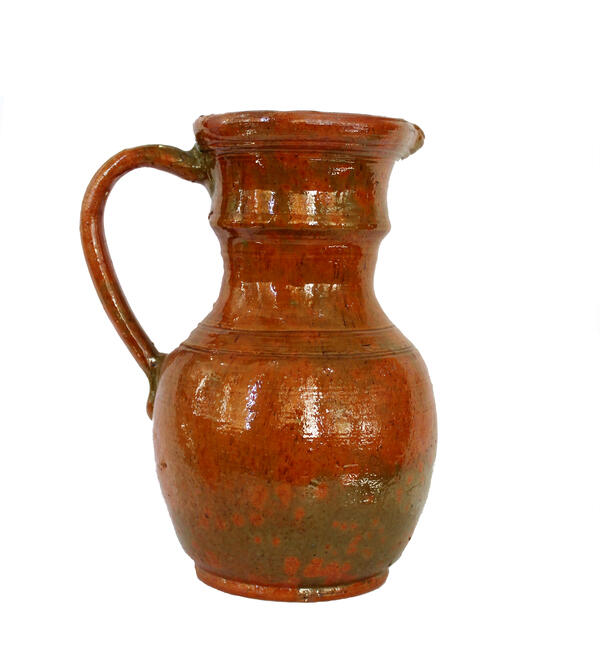The Russian cabin exposition features a clay jug made in Syzran in the 1960s-1970s. Along with other ceramic items, it was acquired by the museum in 1981, being donated by the pottery shop managed by master Aleksey Dronov.
The jug is made from red clay, it features an oval body and was made on a pottery wheel; it is covered in greenish-brown watering on the inside and on the outside. The edge of the neck is bent to one side in such a way that from the outside it looks like an oval collar. There is a spout on one side, and on the other, a massive arching handle is attached.
In Ancient Rus', the most common household utensils were clay tableware. Almost all known types of pottery were made on pottery wheels, and that includes clay jugs. Some were used as everyday utensils while others would have pictures painted on them sporting majolica, Gzhel, or other ornaments and then be used ceremonial utensils during various holidays and festivals.
A jug’s main purpose was to store liquids so jugs were regarded as drinking utensils. The type of beverage determined the shape of the jug: some jugs were wide and low while others were narrow and tall. Today jugs are made from glass and plastic but in the past, the most common material was clay. Clay is a material people have known from ancient times and it may very well have been one of the first materials that people used in day-to-day life.
Clay dishes were made in Syzran as well. In the area of the brick factory, there is a neighborhood that, even to this day, is informally known as the Pots, or the Pot Farms; in the olden days, it was home to numerous pottery shops.
Ceramic dishes are believed to have some unique properties: for example, milk stored in ceramic jugs remains cold and refreshing for a long time. Today jugs are not the most common type of kitchen utensil and many drinks are sold in containers that they can be poured from. However, an elegant jug, especially one with paintings on the sides, can even now serve as a great decoration on a dinner table during a holiday, acting also as a symbol of hospitality and comfort. Many winemakers also prefer to serve expensive wines in ceramic jugs as they tend to preserve all the best properties of the wine for longer than other types of containers.
The jug is made from red clay, it features an oval body and was made on a pottery wheel; it is covered in greenish-brown watering on the inside and on the outside. The edge of the neck is bent to one side in such a way that from the outside it looks like an oval collar. There is a spout on one side, and on the other, a massive arching handle is attached.
In Ancient Rus', the most common household utensils were clay tableware. Almost all known types of pottery were made on pottery wheels, and that includes clay jugs. Some were used as everyday utensils while others would have pictures painted on them sporting majolica, Gzhel, or other ornaments and then be used ceremonial utensils during various holidays and festivals.
A jug’s main purpose was to store liquids so jugs were regarded as drinking utensils. The type of beverage determined the shape of the jug: some jugs were wide and low while others were narrow and tall. Today jugs are made from glass and plastic but in the past, the most common material was clay. Clay is a material people have known from ancient times and it may very well have been one of the first materials that people used in day-to-day life.
Clay dishes were made in Syzran as well. In the area of the brick factory, there is a neighborhood that, even to this day, is informally known as the Pots, or the Pot Farms; in the olden days, it was home to numerous pottery shops.
Ceramic dishes are believed to have some unique properties: for example, milk stored in ceramic jugs remains cold and refreshing for a long time. Today jugs are not the most common type of kitchen utensil and many drinks are sold in containers that they can be poured from. However, an elegant jug, especially one with paintings on the sides, can even now serve as a great decoration on a dinner table during a holiday, acting also as a symbol of hospitality and comfort. Many winemakers also prefer to serve expensive wines in ceramic jugs as they tend to preserve all the best properties of the wine for longer than other types of containers.



